An epic and poetic walk in a Japanese legend’s footsteps
The narrow road to the deep north suitably unfolds like an epic poem. Up mossy steps and down cedar-shaded tracks we flow, fluid as the verse written by 17th-century haiku master Matsuo Basho.
Sometimes we disrupt the rhythm to catch our breath, admire the view, peer at microscopic mushrooms stippling logs so putrefied they must surely have overlain the track when Basho passed by.
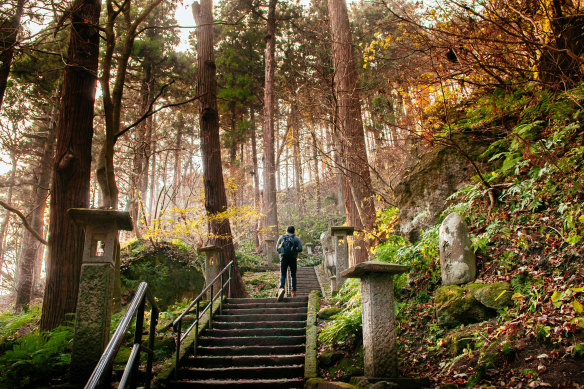
Poetry in motion. Credit: Alamy
His journey began many months’ walk south of here, in Edo (now Tokyo) with his friend and fellow poet, Sora. Mine? My friend and fellow poetry disciple, Amanda.
Tucked into our daypacks are copies of The Narrow Road to the Deep North (Oku-no-hosomichi), Basho’s retelling of his 156-day, 2400-kilometre journey into the northern frontier of Japan’s main island, Honshu.
Our excursion will trace but a fraction of the poet’s steps; we will supplement our meditative wanderings with the modern conveniences of train and car and swap questionable lodgings for convivial ryokans as we strike out across late-summer plains and into the thicketed ranges of Tohoku.
Day one: Tokyo to Sendai
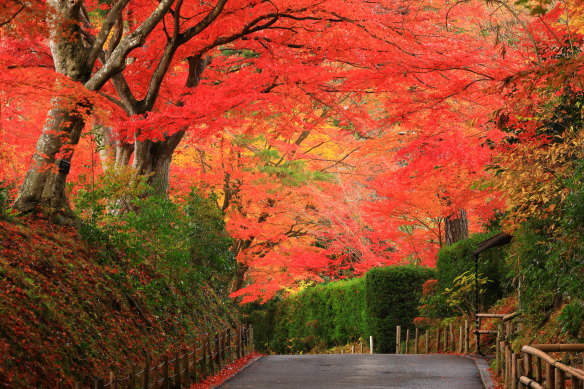
Autumn colours in Iwate Prefecture.Credit: iStock
First, we must shake off the sprawling vestiges of Tokyo, a city whose immensity Basho would have surely distilled into 17 precision-cut haiku syllables, were he alive to experience it.
Burgeoning though it was, the Edo of 1689 was still a low-slung settlement from whose hillocks Basho could discern the faint outline of Mount Fuji as he set off in the gloom of a spring dawn, his torn trousers mended, his hat fixed with a new strap, his sight assailed by cherry blossoms “bidding me a last farewell”.
We, on the other hand, begin our journey in indolence, buying bento boxes and vending-machine coffee at Tokyo station, lining up on the platform, sitting back on the Shinkansen and watching the countryside Basho traversed in a few months flash by in fewer than three hours.
I can imagine, like Basho had, the towns of Iwaki and Hitachi lying somewhere to our right; after we’ve completed our walk, we will travel spontaneously from Sendai, a city of nearly 2.5 million, to the Fukushima coastline, peering inland towards the line of hills the poet trod at the start of his peregrinations.
Where he was sallying forth into a landscape flushed with rhododendron and deutzia blooms, we are bulleting through a late-summer tapestry of ripening rice and the tender shoots of winter vegetables.
“Remember, haiku must contain a seasonal reference,” says Amanda, as we workshop poems to echo the passing scene.
But our doggerel is redundant, for this landscape is itself a flawless haiku. It fills the train’s windows, blooming and shrinking and shredding into fine ribbons of jade and chrome yellow as we reach the outskirts of our destination. See the terminus? The city is approaching; here she is, Sendai.
Waiting for the lift at our hotel that night, we converse merrily in amateur verse. A male American voice surprises us from behind.
“Are you composing haiku?” he asks.
Embarrassed, I turn around to greet the kind-eyed fellow. His name is Bob and he’s from New York; he, too, will be following in Basho’s wake tomorrow morning with his partner, Sono.
Somewhere deep in those woods we’ll discover that Bob is a poet. We will spy the pair occasionally, trailing through the woods like wisps of thread.
Day two: Sendai to Matsushima
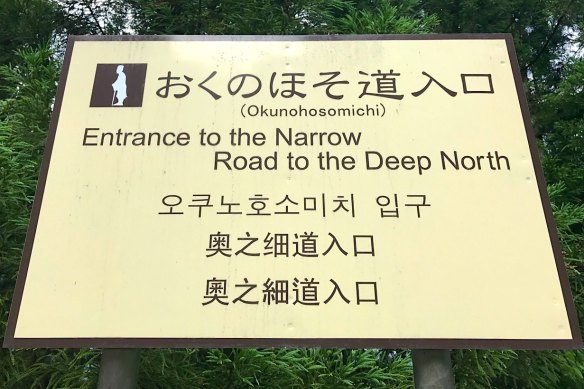
The trailhead.Credit: Walk Japan
Our journey to walk 46 kilometres starts with a single train ride from Sendai to Kokufu-Tagajo, where we disembark and set off on foot towards the ruins of Tagajo Castle. Here stands a cairn so ancient and enduring it moved Basho to tears.
Time has smudged the distance markers inscribed upon it; the base is tessellated with blocks of sunlight pouring in through a latticed enclosure.
Walking through the surrounding iris fields we meet Claire and Kene, an Australian couple we’d seen earlier at Sendai station; they greet us before disappearing over a rise.
Later, we’ll learn that they’ve just completed the far more arduous Kumano Kodo pilgrimage; no wonder they glide with such ease up and down these hillocks.
At lunch – taken in the shade of Japanese cedars – I use the space provided in my route booklet to pen my first and only walking haiku: Hot it is, but there’s/respite under sugi trees/for bumblebees, too.
Should I stick to prose, I wonder?
But the trail spills now from the sugi’s shade onto hot asphalt roads rimmed with suburban houses and community vegetable gardens. Scarlet spider lilies grow wild on the verge.
It’s a steep climb to Shiogama Shrine, but we verily skip from here down to the port, where a boat is waiting to ferry us across Matsushima Bay – “the most beautiful spot in the whole country of Japan,” wrote Basho.
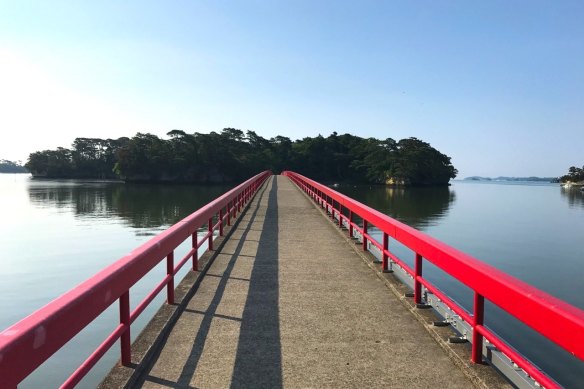
A bridge in Matsushima Bay - “the most beautiful spot in the whole country of Japan.”Credit: Walk Japan
Weather has sculpted recognisable forms from the pine-crowned islets plugging the bay: Kanejima is a bulwark punched with vaulted doorways; Niojima wears a beret and smokes a cigarette.
While Basho carried his baggage on his back, ours has been transferred ahead. But our dining arrangements are surely similar: a kaiseki of such delicacies as beef tongue, burdock soup and candied sweet potatoes.
From our balcony, we watch the bay burnish then blacken as the sun sets on the first day of our own narrow road to the deep north.
Day three: Matsushima to Hiraizumi
Three trains fast-track us this morning to Hiraizumi, a UNESCO World Heritage Site encircled by a low ring of mountains northwest of Sendai.
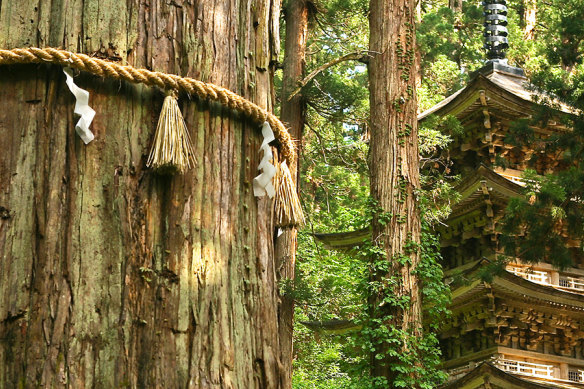
On the trail at Hiraizumi.Credit: Walk Japan
Coppery dragon boats reflect pin-sharp off the pond at Motsuji Temple; a stone etched in Basho’s hand records his impressions: “The summer grass / ’Tis all that’s left / Of ancient warriors”. I’m more fortunate than those warriors, according to the lucky fortune I purchase at the temple: “Things will go well, but be careful not to overdo it,” it says.
I’m grateful for this divination, for the track ascends precipitously through a forest carpeted with wild hops, Japanese mugwort and mushrooms – and inhabited by Japanese black bears.
They’re nocturnal and unlikely to attack, but we thump the bear-warning boards erected along the path nonetheless, and heed the booklet’s suggestion that, “it never hurts to make some noise. Occasional clapping and singing recommended!” “Hello, bears,” Amanda croons. “So nice not to meet you!”
But it’s only dragonflies we see, and golden orb spiders stringing their gossamer webs between the pine trees. Basho is waiting for us at the Chuson-ji temple complex, his assumed likeness echoed in a reposeful sculpture, bamboo staff in hand.
At a gold-leafed structure named Konjikido, a Japanese man hands us a slip of paper on which is written, “Would you like to hear the English commentary?” “Hai!” we respond (Yes!).
It’s a mesmerising story: the hall was constructed a millennium ago to appease the souls of those lost warriors. When Basho arrived, it was wind-ravaged and partially rotted; now it shimmers inside an earthquake-proof building behind a wall of fireproof glass.
Rain starts to fall as we loop back down into Hiraizumi. Tonight’s kaiseki setting recalls the day’s flora: lotus root in the cherry leaf dish, sashimi in a bowl shaped like the underside of a shitake mushroom. Afterwards, we sink into our futons and surrender to sleep.
Day four: Hiraizumi to Akakura Onsen
“West is good, east is bad,” my lucky fortune had also foretold, which is just as well, for today we head west by train and disembark at Naruko Onsen with the throngs who’ve come to buy kokeshi dolls and bathe in sulphurous springs.
This is the longest day on the trail – 14 kilometres – and we make haste, pausing at Shitomae Barrier Gate, where gatekeepers regarded Basho and Sora suspiciously since “few travellers dared to pass this difficult road under normal circumstances.”
A memorial stone recalls Basho’s verdict of the gatekeeper’s lodging: “Bitten by fleas and lice/I slept in a bed/A horse urinating all the time/Close to my pillow”.
Our own menaces are more perilous: “Beware of bees, beware of bears,” reads a sign as we cast a final look across the bucolic sweep of river and farmland before plunging headlong into a tunnel of hardwood forest. Up steps and switchbacks we go, all the while calling out our warnings. In a clearing, we happen upon Bob and Sono.
“I’ll tell you something,” says Bob, “the bears aren’t coming near you. You’re the Mormon Tabernacle Choir of bear-scaring laughter!”
Amused, the pair disappears into the forest. We could cut our walk short at Nakayamadaira Onsen, taking the train to Hojin-no-ie, but we press on past the torii gates at Yama-jinja and along a dew-slicked road winding through an enchanted forest of cedars.
Emerging from it, we pass a farmer whose rice crop will be used to make award-winning sake. We’re dreaming of sake ourselves now, but there’s a shallow stream to ford and a long road to traverse before we reach our rendezvous point with the driver who will take us to our inn.
There, we find that water, not sake, is the wayfarer’s balm: our bodies unknot in the onsen as the Oguni River rushes by; later, my fatigue is transmuted to sleep by the river’s pacifying flow.
Day five: Akakura Onsen to Hijiori Onsen
The six of us set off together from the trailhead, Claire and Kene’s bear bell tinkling up through the switchbacks and dissolving into the forest overhead.
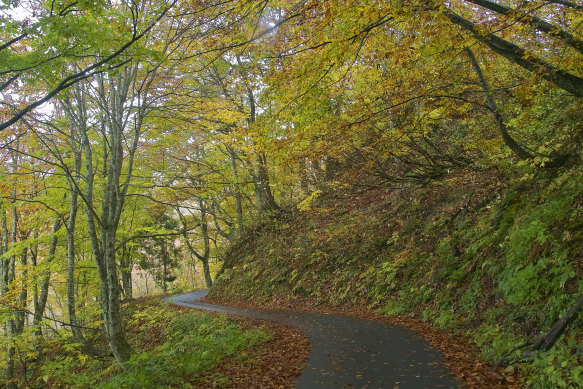
Natagiri Pass.Credit: iStock
Natagiri Pass – the fearful pinnacle of Basho’s journey – is paved with fungi: acid yellow mushrooms, orange chanterelles, lustrous purple toadstools, vermillion spores stippling the ground like blood-spatter. At the top of the pass, Bob stands before the Basho memorial stone.
“Have you been writing haiku on your walk?” I ask him. “Every step of the way,” he says.
A taxi is waiting at the trail-end to take us to Obanazawa, where Basho stayed at safflower merchant Seifu’s house.
We’re waylaid at the Basho and Seifu Historical Document Museum, housed in the home of an Edo-era sake merchant: straw boots of the sort Basho wore on his journey, bouquets of dried safflowers, hand-written haikus: “An eyebrow brush/comes to mind/ when I see blooming safflowers.”
Amanda and I fall asleep in the taxi on the way to Hijiori, a steam-wreathed town where yukata-clothed visitors clop around in geta clogs after soaking in some of Japan’s oldest onsens.
Revived by edamame and black sesame ice-cream, we climb beyond the torii gates towards Jizogura, a shrine founded in 807 by another wanderer, the monk Genno, who healed his broken arm in a nearby onsen. We pass Claire and Kene on their way down.
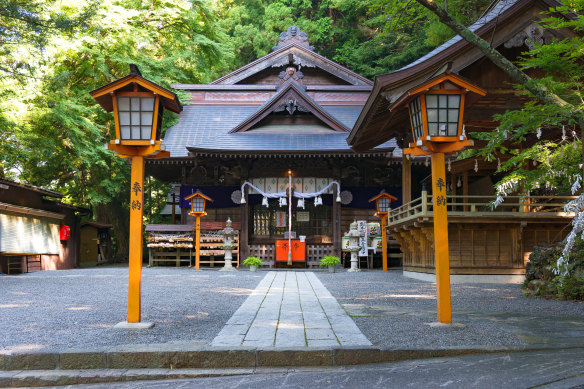
Shinto Shrine at Yamanashi.Credit: iStock
“Take my bear bell,” Claire says.
I attach it to my belt, and it trills reassuringly as we forge through cedar groves, teeter along a cliff-side trail and emerge onto a ridge upon which clings the shrine.
Above it, a chalky ledge is festooned with twists of paper bearing wishes and five-yen coins hung for good luck.
Beyond it, sunlight sifts through rain cloud onto staggered ranges and makes silver of a slip of river. In July each year, devotees hold a festival here; they descend at nightfall bearing torches. Amanda and I warn off bears with our own deterrents: Claire’s bell and our Tabernacle chorus.
Day six: Hijiori Onsen to Yamadera
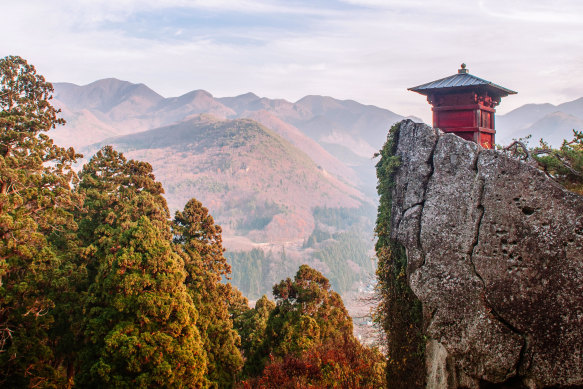
Yamadera Risshaku-ji Temple.Credit: Alamy
At dawn, the women of Hijiori sell produce at a street market: mountain walnuts, water chestnuts, chillies looped into garlands with glossy ribbon.
Does it snow where you’re from, one of them asks? “Here, we get four metres,” she says, sweeping her hand up the side of a building.
But heat flares this morning as we board the first of two trains to Yamadera, where summer’s sounds prompted one of Basho’s most famous haikus: In the utter silence/Of a temple/A cicada’s voice alone/Penetrates the rocks.
The cicadas are silent as Amanda goes off to explore and I walk towards Risshaku-ji temple. I meet Claire and Kene on the way.
“Order the cherry ice-cream,” Kene says, pointing to a nearby shop front. “It’s the best I’ve ever tasted.”
The thought keeps me going up the 1000 steps leading through sunless forest, past sutra wheels and mausoleums and the wall of rock penetrated by those cicadas.
“Keep going,” says a Scottish woman, leaning heavily on a cane. “I’ve got arthritis, and I made it!”
I persevere, surfacing finally at the sun-struck temple. Below me sprawls the Yamadera Valley; a smudged figure waves up at me: Amanda.
“Let’s meet for ice-cream,” I text.
The road has narrowed to a close; our sojourn is over. Kene was right: the cherry ice-cream is exceptional. Its taste lingers on the train ride back to Sendai, from which we disperse: Claire and Kene to Tokyo, Bob and Sono to Nagoya, Amanda and me down the Fukushima coastline.
Precisely where we will stay tonight, we cannot say. Our sentiments echo Basho’s at the end of his journey: “We must take to the road again/Farewell, my friends”.
Five other inspired walks from around the world
Dali’s Pyrenees, Spain and France
Starting in the birthplace of the Fauvist art movement, Collioure, this walk meanders over the foothills of the Pyrenees, across terraced vineyards and through towns like Port Lligat, where surrealist Salvador Dali’s house is now a museum. See utracks.com
Shakespeare’s Country, UK
The Tudor-era scene is set on the road from Moreton-in-Marsh to Shakespeare’s hometown, Stratford-upon-Avon: historic wool towns, cosy inns, streets flush with medieval and Georgian architecture and timeworn paths stitching together the Cotswold countryside. Finish your days at riverside pubs, and fill your cup with the bard’s lore at journey’s end. See auswalk.com.au
Homer’s Odyssey, Greece
Homer’s The Odyssey comes to life in this exploration of the Ionian Islands – encircled by sparkling bays, laced with ancient trails and awash with Greek mythology. Kicking off in the hero Odysseus’ homeland, Lefkada, the walk continues via ferry crossings on the islands of Ithaca and Kefalonia. See responsibletravel.com
Steinbeck’s Coast, US
This walk traces California’s Monterey Bay from Santa Cruz to the town of Monterey, made famous by Nobel Prize-winning writer John Steinbeck’s book Cannery Row. Sink into the shade of redwood forests, explore Monterey’s historic sardine cannery precinct, and keep your eyes peeled for whales, otters and seals out in the bay. See macsadventure.com
Namatjira’s Painted country, Australia
See the striated quartzite landscape that inspired the work of renowned Aboriginal artist Albert Namatjira as you follow the Larapinta Trail through Central Australia’s West MacDonnell Ranges. Namatjira’s country is exemplified on a side-trip to his birthplace, Hermannsburg, where fellow Arrernte artists uphold his legacy. See larapintatrailwalk.com.au
THE DETAILS
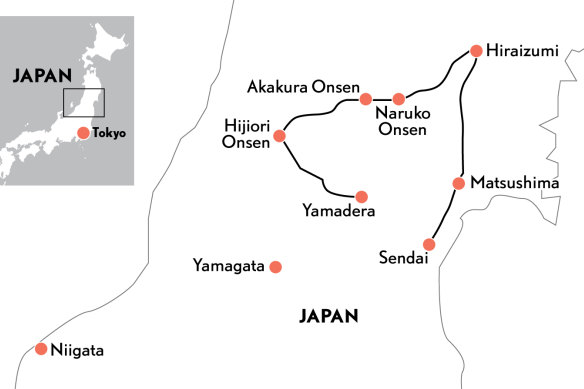
Walk
The pack-free Basho Wayfarer is a level-two walk suitable for those who can comfortably hike for more than four hours. Recommended gear includes a daypack, hiking boots, wind and waterproof jacket, long trousers and walking poles (optional). Luggage is transferred to the accommodation; walkers will be without their luggage on one night, and must carry additional provisions on two days (except for pyjamas and basic toiletries, which are provided at ryokans).
Book
Walk Japan’s self-guided Basho Wayfarer costs about $2360 a person and includes five nights’ accommodation, breakfasts and dinners, luggage transfers, private vehicle transfers and a Japan Rail pass. See walkjapan.com
Fly
Jetstar flies to Tokyo Narita via Cairns and Brisbane (from October 31). See jetstar.com
Train
The walk starts in the city of Sendai, two hours by train from Tokyo station with a Japan Rail pass provided by Walk Japan for the duration of the walk.
More
The writer was a guest of Walk Japan.
Sign up for the Traveller Deals newsletter
Get exclusive travel deals delivered straight to your inbox. Sign up now.